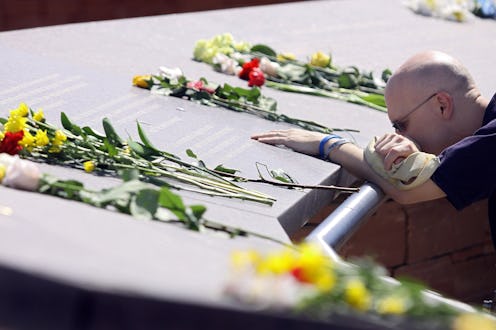News
What To Say When Someone Argues There Was An "Assault Weapons Ban" During Columbine

As students across the nation prepare to walk out of school on Friday in remembrance of the Columbine High School shooting that happened 19 years ago, some critics brought up that the United States already tried outlawing assault weapons in the '90s. In fact, assault weapons were technically banned when the Columbine tragedy took place. So, what was the Federal Assault Weapons Ban? The law that's since expired was largely ineffective because of multiple loopholes — but the number of mass shootings still fell while it was in place.
The Federal Assault Weapons Ban was included in the Violent Crime Control and Law Enforcement Act of 1994, which was signed into law by former President Bill Clinton. It was in effect for 10 years, and it prohibited gun manufacturers from producing 18 specific kinds of semi-automatic firearms, as well as high-capacity magazines. Because it only impacted guns manufactured after the law was in place, it was still legal to own or resell a semi-automatic weapon made before 1994.
Other loopholes left the measure pretty powerless, too. Gun manufactures could make slight modifications to semi-automatic weapons in order to evade the ban, for example. "Relatively cosmetic changes, such as removing a flash hider or bayonet mount, are sufficient to transform a banned weapon into a legal substitute, and a number of manufacturers now produce modified, legal versions of some of the banned guns," a 2004 University of Pennsylvania study reads.
Despite the loopholes, analysts still found that crimes committed with assault weapons decreased between 1994 and 2004. Although criminal use of assault weapons only accounted for about 6 percent of gun crimes before the ban, that number declined after 1994, according to the same University of Pennsylvania study. In some places, criminal use of assault weapons fell by one-third.
The number of mass shootings in America also fell slightly while the ban was in place. Analyzing data on mass shooting that involved five or more deaths before, during, and after the Federal Assault Weapons Ban, John A. Tures, a political science professor at LaGrange College, found that there were 1.69 times as many mass shootings in non-ban years. From 1973 to 1994 — before the assault weapons ban was in place — there were 2.04 mass shootings with five or more deaths per year, according to Tures. From 1994 to 2004 — while the ban was in effect — there were 1.6 shootings per year.
After the ban expired, the number of mass shootings rose drastically. Between 2005 and 2015, the United States experienced 4.18 mass shootings per year. So, those who claim the Columbine shooting is proof that the ban did nothing to prevent mass shootings don't have all the facts. As Tures wrote in Huffington Post in 2016:
But even with the horrible event of 1999, the data shows that the assault weapons ban reduced mass shootings in America, and letting the ban expire dramatically increased the number of mass shootings in the United States.
In the first 12 weeks of 2018, there was an average of one school shooting every week that involved at least one person being shot. Since the February massacre at Marjory Stoneman Douglas High School in Parkland, Florida, that left 17 dead, survivors have called for a federal ban on assault weapons and high-capacity magazines.
Seven states and Washington, D.C. already have a ban on the books: California, Connecticut, Maryland, Hawaii, Massachusetts, New York, and New Jersey. The deadly weapons are still completely legal in the other 42 states, however.
Though legislation that would again ban assault weapons has been introduced in Congress, it's not likely to gain much traction while Republicans control both the House and the Senate. Nevertheless, it's worth examining the previous ban's successes and failures — of which there were both — as gun control activists champion a new ban on assault weapons.